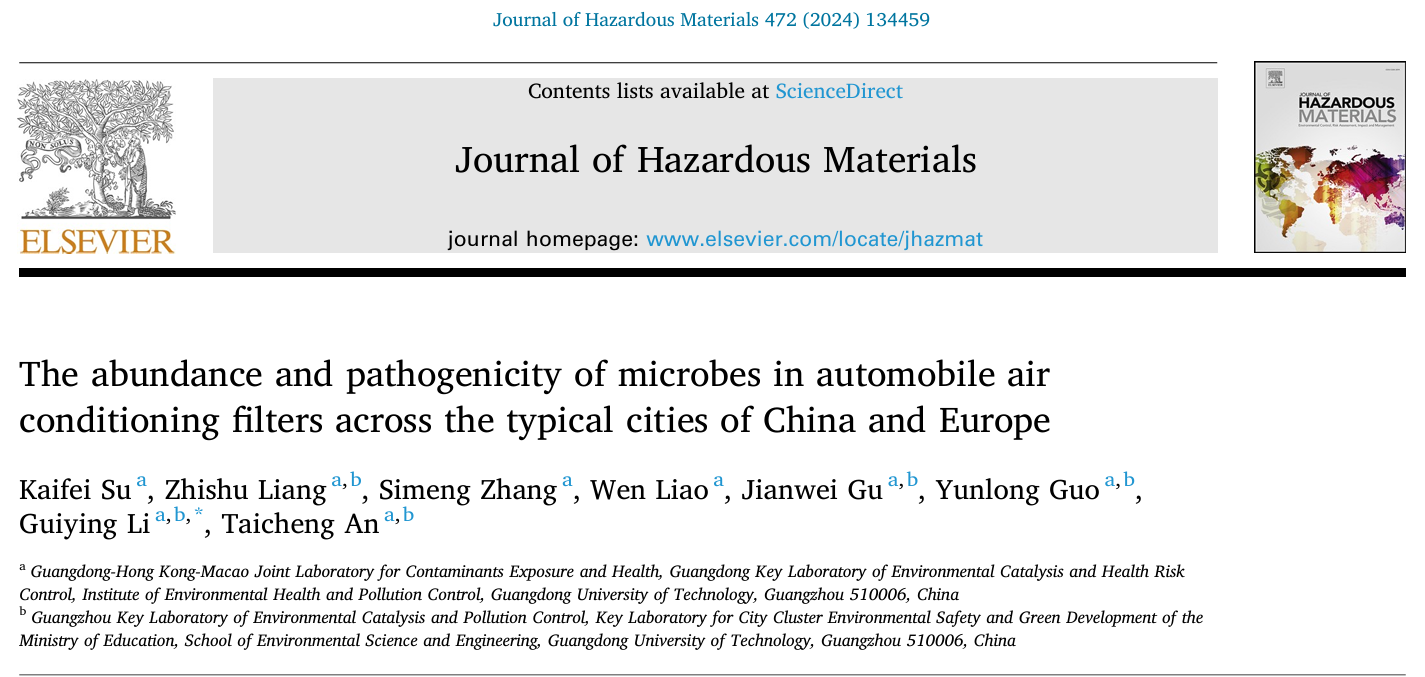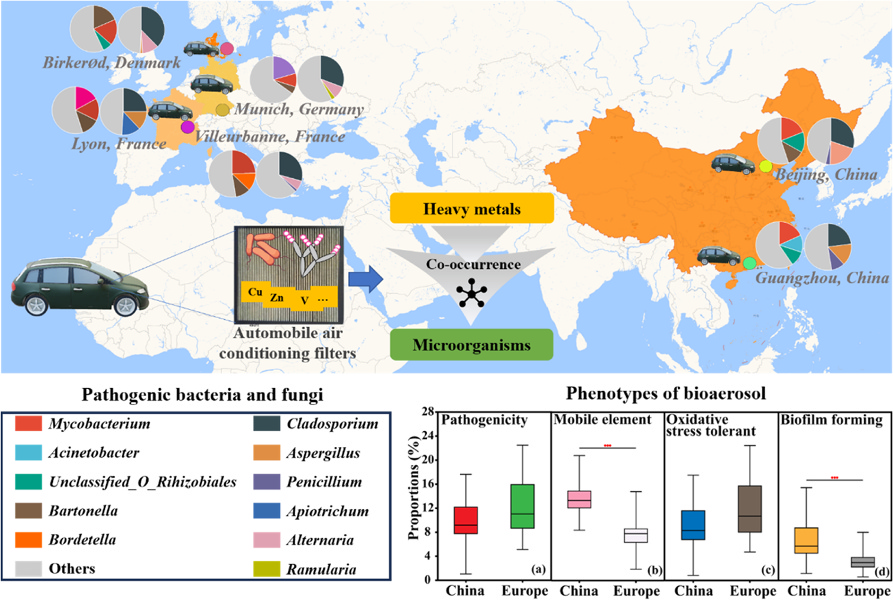近日,广东工业大学环境健康与污染控制研究院、环境科学与工程学院李桂英、安太成教授团队在城市生物气溶胶的污染特征及其健康风险方面取得最新研究进展,研究成果以《The abundance and pathogenicity of microbes in automobile air conditioning filters across the typical cities of China and Europe》为题发表在Journal of Hazardous Materials(2024,472,134459)期刊上。论文第一作者为硕士生苏凯飞,通讯作者为李桂英教授。近年来,区域性生物气溶胶的污染事件频繁发生,导致一系列呼吸疾病的传播,从而威胁到人体健康。本研究使用汽车空调过滤器作为采样器检测了中国和欧洲若干典型城市空气中微生物的丰度和致病性,阐明了不同区域典型城市生物气溶胶的污染特征及其可能存在的健康风险。该研究将引起人们对区域生物气溶胶污染的关注,并为其预防和控制提供了一定的前期研究基础。

论文网址:https://doi.org/10.1016/j.jhazmat.2024.134459
生物气溶胶是悬浮在大气中具有生物活性的微小粒子,包括细菌、真菌、病毒、花粉和过敏原等,它可以通过空气传播并对人体健康产生有害影响。汽车空调(AAC)过滤器可以作为大气中生物气溶胶的的采样器捕获空气中的微生物,并用于监测城市空气中微生物的污染情况。本研究采用AAC过滤器对中国和欧洲若干典型城市空气中微生物的丰度和致病性进行了调查研究,首先采用微生物培养法测定了可培养细菌和真菌的浓度水平,并采用高通量测序技术分析了其微生物群落结构。发现中国和欧洲城市的可培养生物气溶胶污染水平存在一定的差异(ANOVA,P<0.01)。中国城市中最主要的病原菌(Mycobacterium:18.2%~18.9%;Cladosporium:23.0%~30.2%)和欧洲城市相似(Mycobacterium:15.4%~37.7%;Cladosporium:18.1%~29.3%)。除此之外,病原菌 Bartonella、Bordetella、Alternaria 和 Aspergillus 也广泛存在。采用单因素相关性网络图分析,发现中国与欧洲城市细菌/真菌气溶胶群落内部存在显著的相关关系。BugBase 表型预测分析显示,与欧洲城市相比,中国城市大气环境中微生物组具有更高的移动遗传组件丰度和生物膜形成能力,这表明中国城市的生物气溶胶的健康风险可能更高。同时通过相关性 Heatmap 分析了中国与欧洲城市生物气溶胶与环境因子之间的相互作用关系,发现大多数细菌/真菌与温度、区域生产总值、城市规划面积、人口、日照时数、经度和森林覆盖率等因素呈正相关。相反,大多数生物气溶胶与湿度、风速、纬度和海拔高度呈负相关。进一步通过 Network 共现网络分析,发现重金属(如锌)与微生物丰度相关。而且大多数细菌与重金属呈负相关,而真菌对重金属表现出更强的耐受性,这表明重金属对微生物群落的生长和繁殖有显著影响。本研究主要是阐明了社会和环境因素对微生物群落结构形成的影响,为区域生物气溶胶的污染防治提供了一定的实践见解。
图文摘要:

英文摘要:
Bioaerosols are widely distributed in urban air and can be transmitted across the atmosphere, biosphere, and anthroposphere, resulting in infectious diseases. Automobile air conditioning (AAC) filters can trap airborne microbes. In this study, AAC filters were used to investigate the abundance and pathogenicity of airborne microorganisms in typical Chinese and European cities. Culturable bacteria and fungi concentrations were determined using microbial culturing. High-throughput sequencing was employed to analyze microbial community structures. The levels of culturable bioaerosols in Chinese and European cities exhibited disparities (undefinedysis of Variance, P < 0.01). The most dominant pathogenic bacteria and fungi were similar in Chinese (Mycobacterium:18.2–18.9 %; Cladosporium: 23.0–30.2 %) and European cities (Mycobacterium: 15.4–37.7 %; Cladosporium:18.1–29.3 %). Bartonella, Bordetella, Alternaria, and Aspergillus were also widely identified. BugBase analysis showed that microbiomes in China exhibited higher abundances of mobile genetic elements (MGEs) and biofilm formation capacity than those in Europe, indicating higher health risks. Through co-occurrence network analysis, heavy metals such as zinc were found to correlate with microorganism abundance; most bacteria were inversely associated, while fungi exhibited greater tolerance, indicating that heavy metals affect the growth and reproduction of bioaerosol microorganisms. This study elucidates the influence of social and environmental factors on shaping microbial community structures, offering practical insights for preventing and controlling regional bioaerosol pollution.
项目资助:本研究得到了国家重点研发项目(2023YFC3708202和2023YFC3708204)、国家自然科学基金项目(U1901210、42177410、42130611、42377221)、广东省科协青年科技人才培育计划(2022QNRC23)的联合支持。